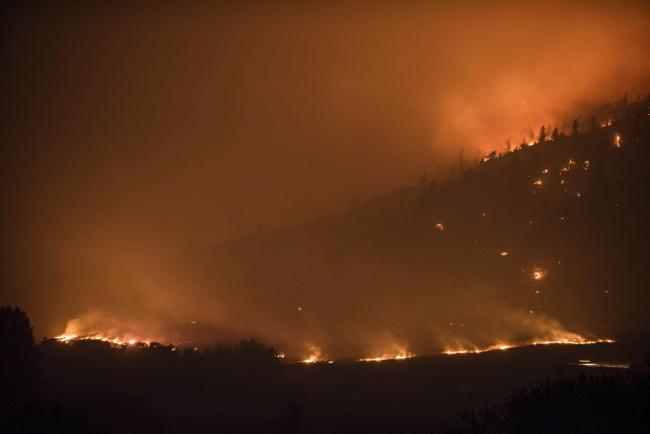Articles Menu

Humanity's contribution to climate change made the catastrophic wildfires across the western Canadian province of British Columbia in 2017 far worse, says a new study by Canadian scientists.
The devastating season saw an area go up in flames in B.C. that was seven to 11 times larger than what would be expected without human influence on the climate, according to scientists at Environment and Climate Change Canada (ECCC) and the University of Victoria (UVic).
Humanity's contribution to #climatechange made the catastrophic wildfires across British Columbia in 2017 far worse, says a new study by Canadian scientists. @ottawacarl reports
The 2017 wildfires burned up over 12,000 square kilometres, forcing 65,000 people from their homes, exposing millions to harmful smoke-filled air and plunging the province into a state of emergency for months.
It was the most disastrous fire in recent memory, breaking records going back six decades — until 2018 brought even larger wildfires.
ECCC and UVic researchers have now completed a study showing how anthropogenic, or human-caused, climate change dramatically increased the risk of wildfires in Canada’s westernmost province. The study showed that humanity’s effect on the climate increased the area burned in 2017 by a factor of seven to 11.
The global scientific consensus is that climate change is being furthered by humans burning fossil fuels like oil, natural gas and coal, which dump carbon pollution into the atmosphere, trapping heat and warming the planet. They say extreme weather events like droughts, floods and wildfires are expected to increase, both in intensity and frequency.
"As the climate continues to warm, we can expect that costly extreme wildfire seasons—like 2017, in B.C.—will become more likely in the future,” said Megan Kirchmeier-Young, a research scientist at ECCC and an author of the study, according to a press release.

“This will have increasing impacts on many sectors, including forest management, public health, and infrastructure,” said Kirchmeier‐Young, who also works at the Pacific Climate Impacts Consortium at UVic.
The subject of the massive increase in forest fires has been a preoccupation for Canadian scientists, who have found that roughly four million hectares of land were affected by forest fires in Canada over the three years to 2016, well above the long-term average.
In May 2016, a terrifying wildfire swept through Fort McMurray, Alberta, forcing an evacuation of at least 88,000 people, the largest in Alberta history and destroying at least $3.7 billion worth of property, more than twice the amount of the previous natural disaster on record.
Federal scientists in the Canadian Forest Service demonstrated in 2018 that large portions of Canada’s vast boreal forest could be at risk of dying off by the end of the century, as climate change will dramatically aggravate the risk of wildfires, drought and insect infestations.
The Intergovernmental Panel on Climate Change, which has written about the increased risk of forest fires posed by climate change, says humans have 12 years to dramatically cut their use of fossil fuels and emissions of carbon pollution, or risk much greater levels of extreme weather and poverty.
The latest study, titled “Attribution of the influence of human-induced climate change on an extreme fire season,” was first published Dec. 13 in the science journal Earth's Future, a trans-disciplinary, peer-reviewed publication, and announced by ECCC on Jan. 8, 2019.
In addition to Kirchmeier‐Young, it also counts ECCC’s Nathan Gillett and Alex J. Cannon, and UVic’s Francis Zwiers and Faron Anslow as co-authors.
The researchers gathered a large body of regional climate model simulations to compare two scenarios, one involving human influence on the climate and one without, using the decade 2011-2020 to represent the current climate and 1961-1970 to represent an alternative climate with reduced human influence.
They then demonstrated the risk factors connected with the wildfire season and the area burned, and found that the maximum temperature anomalies that were observed are over 95 per cent likely to be due to anthropogenic factors.
The scientists also found that extreme forest fires are more likely to intensify in future.
“As a result of increasing temperatures and increasing wildfire risk, extreme area burned amounts like 2017 in B.C. are expected to become more likely in the future. In fact, the 2018 wildfire season in B.C. burned more area than the record-shattering season of 2017,” the study reads.
“Since most of the area burned in 2018 occurred in the northern part of the province (compared to the southern region in 2017), the event attributions discussed above do not apply directly. However, it can be inferred that extreme warm conditions that, along with extreme dryness, contribute to high wildfire potential were made more likely by anthropogenic influence on the climate.”
[Top photo: The Elephant Hill wildfire near Clinton, B.C. on Aug. 8, 2017. Photo by Master Corporal Malcolm Byers, Wainwright Garrison Imaging]